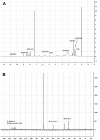Novel Insights into Cr(VI)-Induced Rhamnolipid Production and Gene Expression in Pseudomonas aeruginosa RW9 for Potential Bioremediation
- PMID: 39343606
- PMCID: PMC11473487
- DOI: 10.4014/jmb.2406.06034
Novel Insights into Cr(VI)-Induced Rhamnolipid Production and Gene Expression in Pseudomonas aeruginosa RW9 for Potential Bioremediation
Abstract
Rhamnolipid (RL) is renowned for its efficacy in bioremediating several types of organic and metal contaminants. Nevertheless, there has been a scarcity of studies specifically examining the relationship between this substance and metals, especially in terms of their impact on RL formation and the underlying interaction processes. This study addresses this gap by investigating the RL mechanism in Cr (VI) remediation and evaluating its effect on RL production in Pseudomonas aeruginosa RW9. In this study, P. aeruginosa RW9 was grown in the presence of 10 mg l-1 Cr (VI). We monitored RL yield, congeners distribution, and their ratios, as well as the transcriptional expression of the RL-encoded genes: rhlA, rhlB, and rhlC. Our results revealed that RL effectively reduced Cr (VI) to Cr (III), with RL yield increasing threefold, although with a slight delay in synthesis compared to control cells. Furthermore, Cr (VI) exposure induced the transcriptional expression of the targeted genes, leading to a significant increase in di-RL production. The findings confirm that Cr (VI) significantly impacts RL production, altering its structural compositions and enhancing the transcriptional expression of RL-encoded genes in P. aeruginosa RW9. This study represents a novel exploration of Cr (VI)'s influence on RL production, providing valuable insights into the biochemical pathways involved and supporting the potential of RL in Cr (VI) bioremediation.
Keywords: Bioremediation; Pseudomonas aeruginosa; chromium hexavalent; rhamnolipid.
Conflict of interest statement
The authors have no financial conflicts of interest to declare.
Figures







Similar articles
-
Removal and reduction of chromium by Pseudomonas spp. and their correlation to rhamnolipid production.J Hazard Mater. 2012 Sep 15;231-232:64-9. doi: 10.1016/j.jhazmat.2012.06.038. Epub 2012 Jun 26. J Hazard Mater. 2012. PMID: 22790393
-
Identification and characterisation of short chain rhamnolipid production in a previously uninvestigated, non-pathogenic marine pseudomonad.Appl Microbiol Biotechnol. 2018 Oct;102(19):8537-8549. doi: 10.1007/s00253-018-9202-3. Epub 2018 Jul 10. Appl Microbiol Biotechnol. 2018. PMID: 29992435 Free PMC article.
-
Cadmium effects on transcriptional expression of rhlB/rhlC genes and congener distribution of monorhamnolipid and dirhamnolipid in Pseudomonas aeruginosa IGB83.Appl Microbiol Biotechnol. 2010 Oct;88(4):953-63. doi: 10.1007/s00253-010-2808-8. Epub 2010 Aug 13. Appl Microbiol Biotechnol. 2010. PMID: 20706835
-
Microbial production of rhamnolipids: opportunities, challenges and strategies.Microb Cell Fact. 2017 Aug 5;16(1):137. doi: 10.1186/s12934-017-0753-2. Microb Cell Fact. 2017. PMID: 28779757 Free PMC article. Review.
-
Pseudomonas aeruginosa rhamnolipids: biosynthesis and potential applications.Appl Microbiol Biotechnol. 2000 Nov;54(5):625-33. doi: 10.1007/s002530000443. Appl Microbiol Biotechnol. 2000. PMID: 11131386 Review.
References
-
- Arisah FM, Amir AF, Ramli N, Ariffin H, Maeda T, HAssan MA, et al. Bacterial resistance against heavy metals in Pseudomonas aeruginosa RW9 involving hexavalent chromium removal. Sustainability. 2021;13:9797. doi: 10.3390/su13179797. - DOI
-
- Asri M, Ouafi R, Bahafid W, Elabed S, Koraichi SI. Chromium removal by newly developed microbial consortia supported on wood husk. Desalin. Water Treat. 2023;289:80–91. doi: 10.5004/dwt.2023.29342. - DOI
MeSH terms
Substances
LinkOut - more resources
Full Text Sources
Miscellaneous

